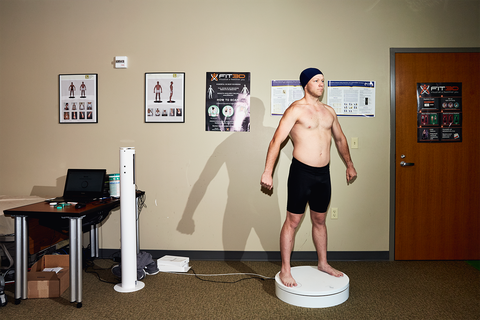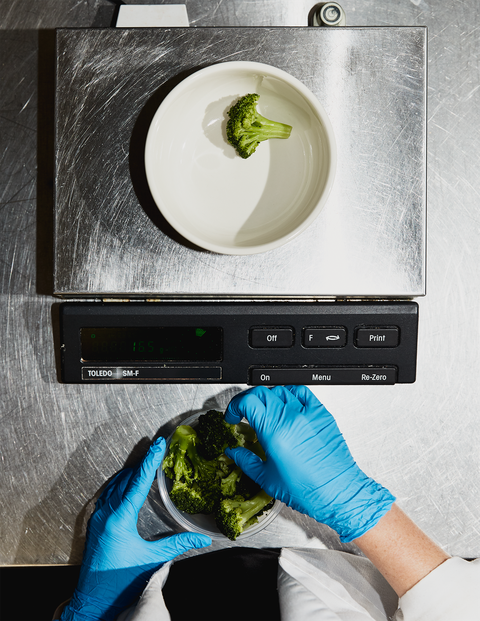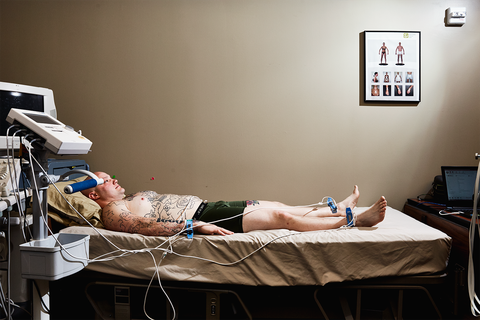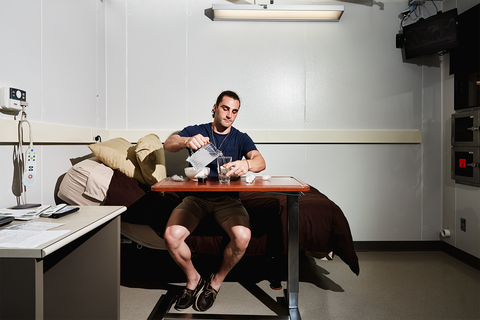This Lab Wants to Help You Lose Weight, Fast

Every week over the past several months, a new volunteer has checked into the “metabolic ward” at the Pennington Biomedical Research Center in Baton Rouge, Louisiana. Each person stays for a total of 24 days in the inpatient unit. He or she is fed meals that are carefully prepared and meticulously measured down to the calorie so that the daily total caloric consumption will be less than what his or her body burns, resulting in weight loss. How much is the question.
Each of the 15 people in the study starts by spending three days inside one of Pennington’s four metabolic chambers. Eric Ravussin, Ph.D., a professor of physiology, genially describes them as “like hotel rooms, but with a glass wall and precise sensors.”
Every inhalation and exhalation is measured to calculate their metabolic burn rate—and whether they’re burning calories from fat, protein, or carbohydrates. The participants next spend 18 days on the 222-acre campus, with every meal and step of exercise recorded. Then they go back in the chamber for three days of evaluation.
Ravussin is measuring in an ultraprecise way not only how much weight the subjects drop but also how their metabolic rate is affected by cutting back their calories. Losing weight is hard enough, but keeping it off is even harder.
Ravussin made headlines with a recent Biggest Loser study that revealed the dramatic drop in calorie burn rate of participants on the show, well below the rate of people who had always been at that weight. So to stay at the same weight, a person who weighed 250 pounds and lost 50 pounds would have to eat less than a person who always weighed 200 pounds.
“It’s like people who lose weight are almost doomed to regain it because of their high metabolic efficiency,” he says. That’s why in this study Ravussin’s team is looking for ways to prop up people’s metabolic rate using a new drug so that they don’t have to restrict their food intake so severely to keep off those lost pounds.

Daymon Gardner
Obesity is like that elephant investigated by the blind men in the Indian fable who arrive at different conclusions depending on whether they’re holding the trunk, the tusk, or the tail. Weight gain can be a result of many different, but often coexisting, issues, from metabolic factors and emotional problems to lack of exercise and overeating. Too often these issues are studied in isolation.
At Pennington, they look at the whole elephant. An Avengers-style team of experts are working together to find new ways to defeat fat. The situation is dire: Seventy-one percent of adults in America are overweight, with 38 percent of them obese, according to the latest data from the CDC.
Recently we spent a few days at Pennington with the researchers and the high-tech hardware they’re using to combat obesity. In addition to the metabolic ward, we visited Corby Martin, Ph.D., director of the center’s Ingestive Behavior, Weight Management & Health Promotion Lab, who is juggling scores of feeding studies investigating everything from how the pace of eating affects satiety to how group dynamics influence food choices at buffets.
A scale invisibly built into a table in the lab continuously records weight as food moves from plate to gullet, and a hidden video camera in the café records food choices.

Daymon Gardner
In another lab, Owen Carmichael, Ph.D., a professor of brain and metabolism imaging, runs a lab that uses functional magnetic-resonance imagery (fMRI) to better understand hunger at the level of the brain. His research is exploring how neural pleasure centers respond to different foods.
Drawing on Pennington’s collective expertise on weight loss, we identified seven “fat types”—seven ways your body, brain, and habits conspire to pack on the pounds. You may be predominantly one type, or you may be a mix of several, but you should be able to identify yourself in this field guide to fat.
The Craver
You eat because you’re listening to your body and your body is weak. It has a very hard time saying no to sugary, salty, fatty comfort foods—the kinds that you know you shouldn’t be eating at all, much less in massive quantities. But they taste so good you do it anyway.
Severe Cravers, says Carmichael, may tell the researchers something like: “I’m driving down the freeway and I see the Golden Arches, and it’s like the rest of the world goes away and there’s a tractor beam drawing me to it.”
Carmichael, an engineer with a doctorate in robotics, is leading a team running experiments on the center’s two fMRI machines to see what parts of your brain light up, and how intensely, when you’re looking at comfort foods versus vegetables.
Meanwhile, Martin and his team use their specific tools to identify people with strong cravings. In studies where the subjects choose their own foods, he assesses cravings with questionnaires and notes how much of each food people eat.
When Cravers are given craved foods, they are more likely to override their satiety cues and finish the plate, or go back for seconds. The insights the lab can’t provide will come out in clinical settings, with study subjects discussing their food issues and filling out questionnaires about habits and preferences. In this way, Martin is both the Alfred Kinsey of eating- related research and its Masters and Johnson, the guy who measures and records what the rest of us merely talk about.
The fix:
The goal is to withstand the temptation of a specific food or vendor. Let’s say you have a particular weakness for baked goods. “We can’t just avoid bakeries for the rest of our lives,” Martin says. “We have to live in harmony with them.”
To that end, he deploys what he calls “exposure with response prevention,” or ERP. He might take a series of group field trips to a bakery in downtown Baton Rouge. The first time, they walk past it. The second time, they linger for a few minutes outside.
The goal is to build up enough resistance to the sights and smells that a Craver can buy a loaf of bread for the family without wolfing down three croissants before he hits the sidewalk. Some of Martin’s temptation- diminishing techniques:
Breathe deep.
Take your mind off the food and put it on something as neutral as breathing. It’s like a cold shower for your body’s overexcited stress response.
Think positive.
Imagine going in for your next doctor’s appointment, and envision how it will feel when you hit your weight and blood-sugar targets.
Plot your moves.
Common scenarios Martin will work through with his subjects include how to go to a crawfish boil (we’re talking southern Louisiana here) without blowing up your eating plan, or a family dinner where your mom expects you to eat all your old favorite foods. Anticipate the caloric war zones and rehearse how you’re going to survive them.
One of Martin’s research partners, Tim Church, M.D., Ph.D., an adjunct Pennington professor whose day job is developing corporate weight-loss programs, notes that it’s important to figure out whether you’re a true Craver—you want a particular, irresistible food—or whether you’re simply a creature of habit.
And if you’re a real-deal Craver, as in you can’t imagine life without cookies or fries or whatever, often the only workable prescription is just saying no, full stop.
“The answer for the craving is extinction,” Dr. Church says. If foods you crave are in the house, throw them out. If you crave and eat certain foods when you watch TV, you might have to not watch for a while until you get over the hump.

The Emo Eater
You’re compelled to eat by emotional factors that have nothing to do with food itself. The brakes might fail because you had a bad day at work or a fight with your spouse, or your team’s best pitcher just blew out an elbow in the middle of the pennant race.
“Some of us handle our emotions just fine, and then some negative event comes up and we go off,” Dr. Church says. “It could be drinking, smoking, or eating,” or some combination.
Alcohol, for example, reduces your inhibitions to everything else, especially food.
The Fix:
“Know your triggers,” Dr. Church says. If they’re not immediately obvious, he says, “next time you go on a bender and eat a pint of ice cream, sit down right afterward and write down what’s upsetting you, as specifically as possible. Unpeel the onion.”
John Oldham, an IT guy from Topeka, Kansas, who lost, as unbelievable as it sounds, 230 pounds on Naturally Slim, the corporate program that Dr. Church helped design, says he unpeeled the onion to discover that his disappointment with his ex-wife was driving much of his out-of-control eating.
“I stopped giving control to her,” he says. Train yourself to put time between the triggering event and your reaction to it. “You’re heading for the refrigerator and you tell yourself, ‘Can I wait ten minutes before I do that?’ ” Dr. Church says. “ ‘And then ten minutes after that?’ ”
Deal with anxiety-producing (and eating-triggering) emotional issues head-on with some kind of talk therapy. And cope with their physical manifestations by drawing from the same menu of mind-body techniques that a Craver might use—for instance, mindful meditation or deep-breathing exercises.
Another solution is to find an activity that makes you feel better but doesn’t involve food. “Go for a walk or bike ride to clear your head,” says Martin. “That can prevent this spiral of mood.”

The Grazer
At work, you’re the guy withthe bowl of nuts or M&M’s on his desk who always seems to be nibbling on something. In the evening, Martin says, you might sit down to watch TV with a bag of chips and end up eating the whole bag.
The Fix:
Martin calls this guy the “passive overconsumer,” and the label points to the solution. You need to become an “active” or “mindful” eater by planning meal schedules, including any snacks you need to keep hunger in check. Then you have to stick to them. If you’re going to eat ice cream, “put a scoop in a bowl and put the carton back in the freezer,” Martin says.
Bryan McCullough, a Dallas video producer who lost 90 pounds on Dr. Church’s program, says, “A chocolate-chip cookie will always sound good to me, but I know if I can have one after my lunch, I don’t have to scarf up the cookies that someone might bring to the office.”
Oldham relies on smartphone-driven food logs and fitness apps. “I track everything.”
Mindful eating begins with an accurate assessment of your hunger. “Clients will tell me, ‘I didn’t realize I was eating when I wasn’t even hungry,’ ” Dr. Church says. “But if you’re hungry, you should eat. If you don’t, there’s a good chance you’ll overcompensate at your next meal.”
Just like the pseudo Craver, Dr. Church says, the Grazer can often be satisfied after he substitutes a low-calorie snack like a bunch of carrots or soda water for the old high-calorie go-to.
But when you are sitting down to a real meal, Martin adds, it’s important to focus on and enjoy the food while you’re eating it. “We train people to be mindful of the fact that they’re sitting down to eat and only to eat, not to also watch TV or read a book,” he says.
The Late-Night Loader
For most of the day you’re uninterested in food. You skip breakfast and have a light lunch. But then at night, you start eating. First there’s a large dinner. The dishes are barely cleared away before you’re snacking on high- calorie autopilot.
“This back-loading of calories really does seem to predispose people to be overweight or obese,” Martin says.
It’s more than a math problem. Human physiology is wired to sleep at night, and preliminary evidence indicates that it’s better to eat our food early in the day and not to eat much at all in the evening. That’s why your body temperature and metabolic rate fall.
Researcher Courtney Peterson, Ph.D., who earned her doctorate in physics from Harvard before moving to Pennington to study nutrition, has just completed two groundbreaking studies on meal timing. Her findings show that late-night eating disrupts insulin sensitivity, raises blood pressure, and decreases fat burning.
“We think that eating later at night causes your body’s clocks to be in different time zones, getting conflicting signals about whether or not to rev up metabolism,” she says.
In one of her studies, subjects ate all three daily meals between 8:00 a.m. and 2:00 p.m. Early results showed that they burned more fat and felt less hungry than a control group eating meals on a normal schedule. Peterson says the first group’s biggest complaint was feeling too full on the compressed schedule, not feeling famished at nighttime.
One alumnus of the study, Jeff Coslan, from Independence, Louisiana, says he dreaded that overstuffed feeling eating dinner in the early afternoon, but at the end of the five-week test run, he’d lost weight and all of his numbers—blood sugar, blood pressure, lipids—had significantly improved.
Even your grandparents wouldn’t consider having dinner earlier than 4:00 p.m. But if the final research shows the same results, there is a practical implication: Eat dinner as early as you can, before insulin sensitivity clocks out. “It’s ironic that we’ve focused so long on whether it’s good or bad to skip breakfast,” Peterson says. “Dinner, and when you eat it, may be the most important meal of the day.”
The Fix:
Plan early meals:
Work out a meal schedule that ends with dinner by 7:00 p.m.
Find replacement activities:
Until you’re familiar with this new feeding pattern, look for ways to keep yourself busy that don’t involve food and drink—working out, for example.
Get your z’s:
Limit the late nights and you’ll cut down on the opportunities to ruin your eating strategies. That’s especially important, if more challenging, to do on weekend nights, when most people overindulge.
Front-load your diet:
Eat breakfast like a king, lunch like a prince, and dinner like a pauper.
Slow down:
It takes roughly 20 minutes for a full stomach to tell the brain to stop eating. Only by eating slowly will you give that feeling of satiety a chance to catch up.
The Sweet-Seeking Missile
You’ve probably heard that sugar is uniquely damaging to your metabolism, your waistline, and your overall health. And yet you just can’t stop yourself. It’s like you’re addicted to the white powder.
This “lone gunman” theory that puts sugar at the center of everything that’s gone wrong with our diet sounds convincing, and it certainly sells a lot of books. But so far, the evidence is underwhelming that sugar is much or any worse than other refined carbs like white flour. However, since so many of the junk calories we consume are in the form of sugar, it deserves its newfound status as public-health enemy number one. (So long, saturated fat.)
The Fix:
Dodge stealth sugar:
Many processed foods have added sugar. The obvious strategy is to read nutrition labels. But it only works if you know the many names for hidden sugar. They include: agave nectar, barley malt syrup, caramel, corn syrup, dextrose, fructose, galactose, glucose, high-fructose corn syrup, honey, lactose, maltose, maple syrup, molasses, sucrose.
Avoid sugary drinks:
They pack a double punch—the calories themselves and the fact that the body doesn’t register fullness from liquids as readily as it does from solid food. Martin, Carmichael, and John Apolzan, Ph.D., are working together to measure that satiety difference neurologically, feeding subjects either sugary taffy or a sugary liquid and then comparing their fMRIs when they look at images of various foods afterward.
Retrain your taste buds:
Eat more whole foods, Martin says, and fewer processed foods. You’ll be cutting down on added sugar and calories. “I call it weight loss through the back door,” he says. An excellent first step: If you’re a snacker at work, trade the candy and doughnuts for raw vegetables and fruit—besides being healthy, the fruit will appease the sweet tooth.
Go on a low-carb plan:
If your doctor tells you your blood-sugar level is on the high side (often after an above-normal hemoglobin A1C test result), going on a low-carb diet may help. Avoid the “whites” (sugar, flour, bread, etc.) and load up on protein—one gram per pound of your goal body weight—and healthy fats.
The Regainer
Even the most dedicated dieters struggle to maintain their new, lower weight once the motivation wears off and the hunger kicks in. Long-term weight-loss studies, in fact, show a disturbing trend: Around the six-month mark, just about everybody stops losing weight and starts to put the pounds back on.
The problem is that your weight-reduced body is wired differently. You burn fewer calories, and thanks to lower levels of leptin, a satiety hormone, you want to eat more. “It’s like you have a spring pulling you back to your original weight,” Ravussin says.
The Fix:
While exercise plays a small role in weight loss, it’s a major factor in weight-loss maintenance. Dr. Church and Martin have published a new study that suggests that your body needs physical activity to get your appetite to match up with your energy expenditure.
“Exercise is a safety valve,” Dr. Church says. “If eating or not eating an extra 200 calories every day makes the difference between maintaining a healthy weight and regaining it, then burning off 1,000 calories a week in the gym just makes the odds of pulling it off that much greater.”
Dr. Church’s studies show that doing both cardio and strength training is better than doing either one alone. Endurance exercise burns lots of calories while you’re doing it, and lifting increases, or at least maintains, muscle mass. The combination helps clear sugar and fatty acids from your bloodstream, either by using them for energy or by storing glucose in muscles while you recover from your workouts.
Keep a food diary:
Exercise is just part of the solution. Sometimes you have to inventory all lifestyle elements, including diet. “For a lot of people, food diaries are often more trouble than they’re worth,” Church says. “But for the guy who keeps regaining, it’s superimportant. He’s got to find out where he’s going wrong.”

Daymon Gardner
The Clueless Compensator
Dr. Church and Martin are publishing a new study with a startling conclusion. Study subjects who exercised a lot (220 minutes a week on a treadmill while being watched like hawks by the Pennington staff) didn’t lose any more weight than people who exercised about half as much. The study authors used some fancy lab science (the “doubly labeled water” technique to measure energy intake and expenditure; don’t ask!) to arrive at a simple finding. People who exercise a lot feel that they’ve “earned” the right to eat significantly more calories. Sorry, it doesn’t work that way.
The Fix:
Don’t overestimate YOUR burn:
At rest, your body burns about one calorie per kilogram of body weight per hour, or 91 calories for a 200-pound guy. Run five miles in an hour and you burn an extra 686 calories, which sounds like a lot until you realize it’s the equivalent of a large slice of cheesecake, which you can inhale in less time than it takes to change out of your sweaty running gear.
Avoid the workout/veg-out cycle:
Your awesome workout can have a pernicious side effect that has nothing to do with food. If you’re so tired afterward that you move less than usual for the next day or two, you’re lucky if you break even on calories in and out. “The best exercise program,” says Dr. Church, “is one that leaves you feeling energized, like you can’t wait to get back out there and hit it again.”
Get your metabolism in order:
Dr. Church and Martin have found that subjects with high blood sugar and impaired insulin response were three times as likely to overeat after a workout. Their working theory is that they burn a higher percentage of carbs when they exercise, causing a drop in blood sugar, which in turn increases appetite.
However, over time, a steady program of moderate, sub-max workouts can improve your insulin sensitivity. When insulin is more responsive, you have less circulating blood glucose, burn a higher percentage of fat for energy, and feel less postworkout hunger. Win, win, win!
Stop looking for a reward:
The subjects in the Church-Martin study who thought they deserved a bonus for a hard workout were more likely to compensate with calories they couldn’t afford. You aren’t a child; you don’t need a treat for taking your booster shot like a big boy. Exercise for its own sake, not for the chocolate- chip Clif Bar you’ll give yourself when it’s over.
Source: Read Full Article
